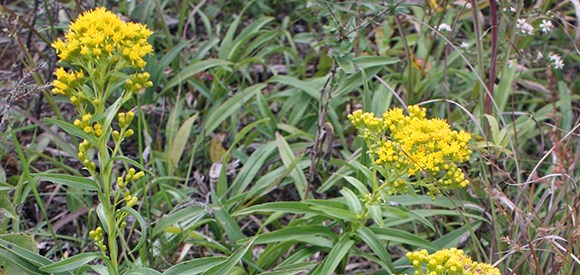Last updated: January 5, 2017
Article
Prescribed Fire Partnership Increases Locally Rare Plant, Ozark National Scenic Riverways

NPS
In September 2014, after fuels reduction and prescribed fire, Ozark National Scenic Riverways saw an increase by 1,026 percent in rare Riddell’s goldenrod plants, a fall-blooming goldenrod important to monarch butterflies. Six entities worked together to maintain and restore a resilient landscape on NPS, Missouri Department of Conservation, and Nature Conservancy lands.
If you think monarch butterflies have become noticeably less common in the last several years, you are correct. According to studies, monarch butterflies have declined 90 percent in the last 20 years. Many factors have contributed to this steep decline, but a primary reason is believed to be “clean farming,” a practice that removes plants from fields that are often considered to be weeds. Some of the plants that are removed may be food for butterflies.
Monarch butterflies depend on a variety of wildflowers for nectar to fuel their tremendous fall migration from Canada to Mexico. One specific class of wildflower affected by the practice of clean farming is fall-blooming goldenrods, a significant nectar source for monarchs and many other beneficial pollinators. In September 2014, after fuels reduction and prescribed fire, Ozark National Scenic Riverways saw an increase in the number of rare Riddell’s goldenrod plants, a fall-blooming goldenrod.
In the Ozarks, Riddell’s goldenrod (Solidago riddellii), is a rare but characteristic wetland, or fen, plant that depends on significant sunlight and wet/damp organic soil to produce viable seed. In the absence of the historic fire regime, the Riddell’s goldenrod population at the Mill Mountain fen was being shaded out by invasive eastern red cedars.
The Ozark National Scenic Riverways fuels crew cut the invasive cedars and pile-burned them during the winters of 2012 and 2013. The fen was also treated with fire during the Mill Mountain/Buzzard Mountain prescribed fire on April 13, 2013. The response of the native grasses and wildflowers was remarkable. Data obtained from two Riddell’s goldenrod monitoring plots, each 10 meters by 25 meters, showed a population increase of 1,026 percent over pre-management numbers. Translated into actual numbers, the Riddell’s goldenrod population increased from 115 plants in 2011 to 1,295 plants in mid-September 2014.
The Mill Mountain/Buzzard Mountain prescribed fire included both NPS land and Missouri Department of Conservation land. This partnership was further supported on the day of the burn by wildland fire staff from Buffalo National River, The Nature Conservancy, AmeriCorps-St. Louis, and the Winona Rural Fire Department. It is a true measure of success when staff from six entities join together to accomplish a common goal safely.
Originally, NPS had two prescribed fire units totaling 710 acres in the Mill Mountain and Buzzard Mountain area. Through cooperation with the Missouri Department of Conservation, these two units were consolidated into one, increasing the unit’s size to 1,231 acres. The expanded unit also included two fens on land owned by The Nature Conservancy containing the highest concentration of rare plants in Missouri. Over a dozen rare plant species are found there, all of which benefit from regular fire management.
The expansion greatly increased operational safety and efficiency by expanding the perimeter of the unit to an existing road system. It also dramatically decreased the cost of the project compared to previous years, reducing the average cost from $30.00 per acre to $12.00 per acre.
Ozark National Scenic Riverways uses prescribed fire to restore glades and woodlands to benefit many species that are currently declining, while also restoring fuel levels to their historic norms. The success of this project was measurable in numerous ways, but the ultimate measure of success may be the discovery of other fire-benefitted species. Hopefully another rare wildflower that butterflies depend on for food will respond to fire as well as the Riddell’s goldenrod.
Contact: Dan Drees, fire ecologist
Email: daniel_drees@nps.gov
Phone: (573) 323-8027
